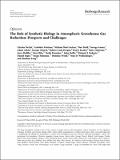| dc.contributor.author | Patrinos, Aristides | |
| dc.contributor.author | MacCracken, Michael | |
| dc.contributor.author | Drell, Dan | |
| dc.contributor.author | Annas, George | |
| dc.contributor.author | Arkin, Adam | |
| dc.contributor.author | Church, George | |
| dc.contributor.author | Cook-Deegan, Robert | |
| dc.contributor.author | Jacoby, Henry | |
| dc.contributor.author | Lidstrom, Mary | |
| dc.contributor.author | Melillo, Jerry | |
| dc.contributor.author | Milo, Ron | |
| dc.contributor.author | Paustian, Keith | |
| dc.contributor.author | Reilly, John | |
| dc.contributor.author | Roberts, Richard J | |
| dc.contributor.author | Segrè, Daniel | |
| dc.contributor.author | Solomon, Susan | |
| dc.contributor.author | Woolf, Dominic | |
| dc.contributor.author | Wullschleger, Stan D | |
| dc.contributor.author | Yang, Xiaohan | |
| dc.contributor.author | Delisi, Charles | |
| dc.date.accessioned | 2021-10-27T19:52:14Z | |
| dc.date.available | 2021-10-27T19:52:14Z | |
| dc.date.issued | 2020 | |
| dc.identifier.uri | https://hdl.handle.net/1721.1/133344 | |
| dc.description.abstract | <jats:p>The long atmospheric residence time of CO<jats:sub>2</jats:sub> creates an urgent need to add atmospheric carbon drawdown to CO<jats:sub>2</jats:sub> regulatory strategies. Synthetic and systems biology (SSB), which enables manipulation of cellular phenotypes, offers a powerful approach to amplifying and adding new possibilities to current land management practices aimed at reducing atmospheric carbon. The participants (in attendance: Christina Agapakis, George Annas, Adam Arkin, George Church, Robert Cook-Deegan, Charles DeLisi, Dan Drell, Sheldon Glashow, Steve Hamburg, Henry Jacoby, Henry Kelly, Mark Kon, Todd Kuiken, Mary Lidstrom, Mike MacCracken, June Medford, Jerry Melillo, Ron Milo, Pilar Ossorio, Ari Patrinos, Keith Paustian, Kristala Jones Prather, Kent Redford, David Resnik, John Reilly, Richard J. Roberts, Daniel Segre, Susan Solomon, Elizabeth Strychalski, Chris Voigt, Dominic Woolf, Stan Wullschleger, and Xiaohan Yang) identified a range of possibilities by which SSB might help reduce greenhouse gas concentrations and which might also contribute to environmental sustainability and adaptation. These include, among other possibilities, engineering plants to convert CO<jats:sub>2</jats:sub> produced by respiration into a stable carbonate, designing plants with an increased root-to-shoot ratio, and creating plants with the ability to self-fertilize. A number of serious ecological and societal challenges must, however, be confronted and resolved before any such application can be fully assessed, realized, and deployed.</jats:p> | |
| dc.language.iso | en | |
| dc.publisher | American Association for the Advancement of Science (AAAS) | |
| dc.relation.isversionof | 10.34133/2020/1016207 | |
| dc.rights | Creative Commons Attribution 4.0 International license | |
| dc.rights.uri | https://creativecommons.org/licenses/by/4.0/ | |
| dc.source | BioDesign Research | |
| dc.title | The Role of Synthetic Biology in Atmospheric Greenhouse Gas Reduction: Prospects and Challenges | |
| dc.type | Article | |
| dc.contributor.department | Sloan School of Management | |
| dc.contributor.department | Massachusetts Institute of Technology. Joint Program on the Science & Policy of Global Change | |
| dc.contributor.department | Massachusetts Institute of Technology. Department of Earth, Atmospheric, and Planetary Sciences | |
| dc.relation.journal | BioDesign Research | |
| dc.eprint.version | Final published version | |
| dc.type.uri | http://purl.org/eprint/type/JournalArticle | |
| eprint.status | http://purl.org/eprint/status/PeerReviewed | |
| dc.date.updated | 2021-07-01T14:55:48Z | |
| dspace.orderedauthors | DeLisi, C; Patrinos, A; MacCracken, M; Drell, D; Annas, G; Arkin, A; Church, G; Cook-Deegan, R; Jacoby, H; Lidstrom, M; Melillo, J; Milo, R; Paustian, K; Reilly, J; Roberts, RJ; Segrè, D; Solomon, S; Woolf, D; Wullschleger, SD; Yang, X | |
| dspace.date.submission | 2021-07-01T14:55:49Z | |
| mit.journal.volume | 2020 | |
| mit.license | PUBLISHER_CC | |
| mit.metadata.status | Authority Work and Publication Information Needed | |
